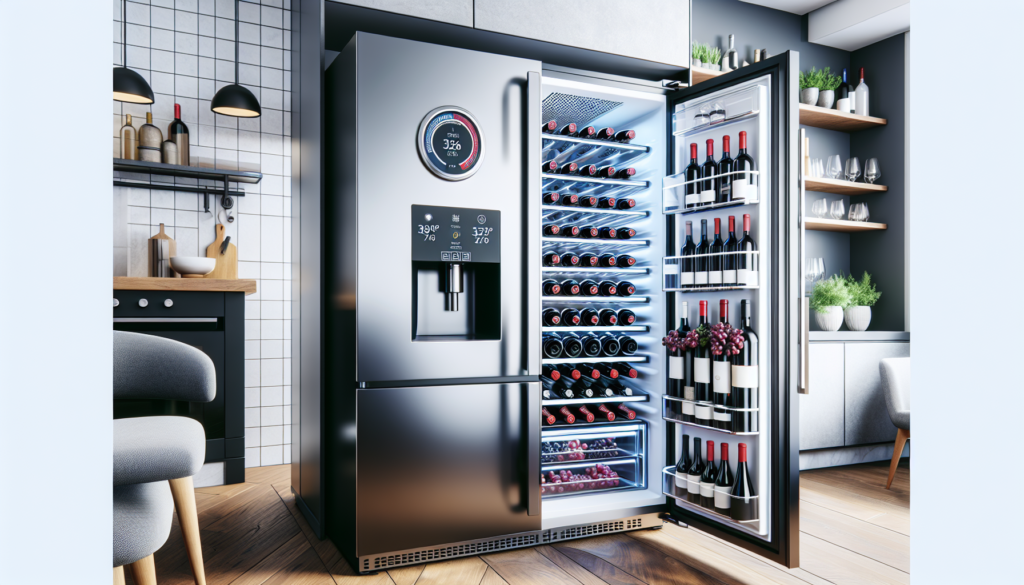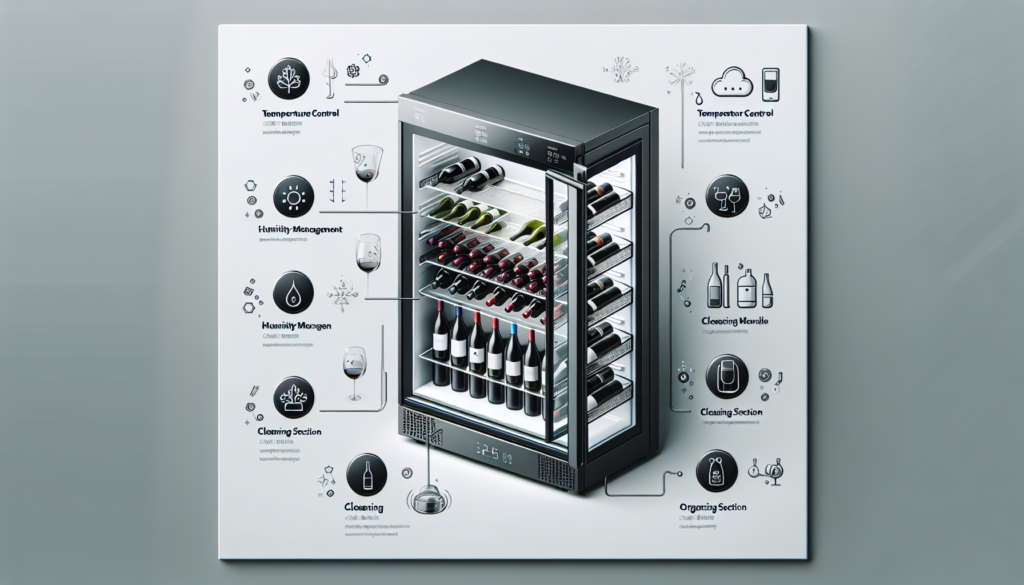Maintaining your wine fridge is essential to ensure the longevity and perfect storage conditions for your precious bottles. From regular cleaning to monitoring the temperature and humidity levels, taking care of your wine fridge will guarantee that your wines are always at their best. In this article, we will guide you through the important steps of wine fridge maintenance, so you can enjoy your favorite vintages for years to come. So, let’s get started and make sure your wine fridge is in top shape!
Checking the Temperature
Setting the ideal temperature
Setting the ideal temperature for your wine fridge is crucial to ensuring that your wine is properly stored and preserved. The ideal temperature for most wines is around 55°F (13°C), although this can vary depending on the type of wine. Red wines generally prefer slightly warmer temperatures, between 55°F and 65°F (13°C and 18°C), while white wines and sparkling wines prefer cooler temperatures, between 45°F and 50°F (7°C and 10°C).
Using a thermometer
To accurately monitor the temperature inside your wine fridge, it is recommended to use a reliable thermometer. Place the thermometer in a central location within the fridge, away from any direct contact with bottles or the cooling unit. This will provide you with an accurate reading of the internal temperature and help you make any necessary adjustments.
Adjusting the temperature
If you find that the temperature inside your wine fridge is not within the desired range, you may need to make some adjustments. Most wine fridges have a temperature control dial, allowing you to increase or decrease the temperature as needed. Keep in mind that any adjustments should be made gradually to avoid temperature fluctuations that could negatively impact the quality of your wine.
Monitoring temperature fluctuations
Temperature fluctuations can be detrimental to the aging and storage of your wine. It is important to regularly monitor the temperature inside your wine fridge to ensure it remains stable. Fluctuations in temperature can cause the wine to expand and contract, potentially leading to leakage or spoilage. If you notice significant temperature fluctuations, it may be necessary to troubleshoot the issue or seek professional assistance.
Cleaning the Wine Fridge
Unplugging the fridge
Before starting the cleaning process, it is important to unplug the wine fridge to ensure your safety. This will prevent any potential accidents and allow you to clean the fridge without any electrical components being active.
Removing the bottles
To clean the interior of your wine fridge effectively, it is necessary to remove all the bottles. Carefully take them out and place them in a safe and temporary location, ensuring they are not exposed to direct sunlight or extreme temperatures.
Cleaning the interior
Using a mild detergent or cleaning solution, gently wipe down the interior surfaces of the wine fridge. Pay close attention to any spills or stains, making sure to thoroughly clean them. Avoid using harsh chemicals or abrasive materials that could damage the fridge’s interior.
Cleaning the exterior
To keep your wine fridge looking pristine, it is important to regularly clean the exterior surfaces. Use a soft cloth or sponge and a mild cleaning solution to wipe down the exterior, including the door and handle. Be cautious not to scratch or damage any delicate parts of the fridge.
Cleaning the shelves
The shelves in your wine fridge are likely to accumulate dust, dirt, and possibly even residue from spilled wine. Remove the shelves one by one and wash them with warm, soapy water. Make sure to rinse them thoroughly and allow them to dry completely before placing them back inside the fridge.
Cleaning the door seal
The door seal, also known as the gasket, plays a crucial role in maintaining the temperature and humidity levels inside your wine fridge. It is important to regularly clean the door seal to prevent any debris or food particles from compromising its effectiveness. Use a mild detergent and a soft cloth to carefully clean the seal, ensuring there is no residue left behind.
Cleaning the condenser coils
The condenser coils are responsible for removing heat from the wine fridge. Over time, these coils can accumulate dust and dirt, hindering their efficiency and potentially causing temperature fluctuations. Use a vacuum or a soft brush to gently clean the condenser coils, removing any debris that may have accumulated. Regularly cleaning the condenser coils will help prolong the life of your wine fridge and maintain its optimal performance.
Cleaning the fan
The fan in your wine fridge circulates the air, promoting consistent temperature distribution. It is important to clean the fan regularly to prevent any buildup of dust or debris that could impact its functionality. Use a soft brush or cloth to carefully clean the fan blades, ensuring they are free from any obstructions. This will help to maintain proper airflow and prevent any potential issues with temperature regulation.

Organizing and Storing Wine Bottles
Sorting wine bottles
Properly sorting your wine bottles not only helps with organization but also ensures that you can easily access specific bottles when needed. Consider sorting your wine bottles by type, region, or aging potential. This will allow you to quickly find the bottle you are looking for without disturbing the rest of your collection.
Positioning the bottles
When storing wine bottles in your fridge, it is essential to position them correctly to maintain their quality. Store the bottles horizontally, especially those with cork closures, to keep the cork moist and prevent it from drying out. This will help maintain a proper seal and prevent any oxygen from entering the bottle.
Avoiding vibration
Excessive vibration can negatively impact the aging process of your wine. Avoid placing the wine fridge in a location with high levels of vibration, such as near a washing machine or a loud appliance. Additionally, be cautious when moving the fridge or storing heavy items on top of it, as this can also cause unwanted vibrations.
Avoiding direct sunlight
Direct sunlight can cause fluctuations in temperature and damage the quality of your wine. Avoid placing your wine fridge in an area with direct sunlight exposure, as this can lead to premature aging and spoilage. Consider keeping the fridge in a cool and dark location to provide optimal storage conditions for your wine collection.
Avoiding drastic temperature changes
Temperature changes can disturb the aging process of your wine and potentially impact its flavor and quality. Avoid placing the wine fridge in areas with frequent temperature fluctuations, such as a garage, as this can affect the stability of the temperature inside the fridge. Maintaining consistent temperature levels is essential for preserving your wine.
Maintaining proper humidity levels
Proper humidity levels are crucial for wine storage, as they help prevent the corks from drying out or becoming moldy. Ideally, the humidity inside your wine fridge should be kept between 50% and 70%. If the humidity levels are too low, consider using a humidifier, and if they are too high, use a dehumidifier or silica gel packs to regulate the moisture.
Using wine racks or shelves
Utilizing wine racks or shelves in your wine fridge can help maximize the storage capacity and protect your bottles from any potential damage. Wine racks help keep bottles stable and organized, preventing them from rolling around and potentially breaking. Investing in wine racks or shelves designed specifically for wine storage can greatly enhance the functionality and organization of your wine fridge.
Labeling and inventory management
To easily identify and locate specific bottles in your wine fridge, it is beneficial to label them and maintain an inventory. Consider using labels or tags to indicate important information about each bottle, such as the type of wine, vintage year, or special occasions for which it is reserved. Additionally, keeping an updated inventory will help you keep track of your wine collection and ensure that nothing is misplaced or forgotten.
Preventing Bad Odors
Removing expired or spoiled wine
Regularly check your wine collection for any bottles that may have expired or become spoiled. These bottles can emit unpleasant odors that may affect the rest of your collection. Remove any expired or spoiled wine promptly to prevent the spread of unwanted smells within your wine fridge.
Avoiding strong-smelling foods
Strong-smelling foods, such as onions or garlic, can release odors that may permeate through the wine fridge and affect the taste and aroma of your wine. Keep these types of foods away from your wine fridge and store them in a separate location to prevent any unwanted smells from transferring to your wine bottles.
Keeping the fridge dry
Excess moisture can contribute to the growth of mold and mildew, leading to unpleasant odors. Regularly check and clean any water or condensation that may accumulate inside your wine fridge. Ensure that the fridge is properly ventilated to allow for proper air circulation and reduce the chances of moisture buildup.
Using baking soda
Baking soda is a natural odor absorber and can help eliminate any lingering smells in your wine fridge. Place an open container of baking soda on one of the shelves and leave it for a few days. The baking soda will help absorb any unwanted odors, leaving your wine fridge smelling fresh and clean.
Ventilating the storage area
Proper ventilation is essential for maintaining a fresh and odor-free environment in your wine fridge. Ensure that the space where the fridge is located has adequate airflow and ventilation. Avoid placing the fridge in a tightly enclosed space that may prevent proper air circulation, as this can contribute to the buildup of unwanted odors.

Maintaining the Door Seal
Inspecting the door seal
Regularly inspecting the door seal of your wine fridge is essential to ensure that it remains in good condition and functions properly. Check for any signs of wear, cracking, or damage. A damaged door seal can lead to temperature fluctuations and compromise the efficiency of your wine fridge.
Cleaning the door seal
Keeping the door seal of your wine fridge clean is important for maintaining its effectiveness. Gently wipe down the door seal with a mild detergent or cleaning solution to remove any debris or residue. Pay close attention to any areas that may be difficult to reach, as dirt or grime buildup can affect the seal’s performance.
Replacing the door seal
If you notice any significant damage or signs of wear on the door seal, it may be necessary to replace it. Consult the manufacturer’s guidelines or contact customer support for the specific steps required to replace the door seal of your wine fridge. A properly functioning door seal is crucial for maintaining the optimal temperature and humidity levels inside the fridge.
Preventing Frost Build-up
Checking the door seal
Frost build-up in your wine fridge can be an indication of a faulty door seal. Regularly check the door seal for any gaps or damage that may allow warm air to enter and cause condensation. If you notice any issues with the door seal, refer to the section on maintaining the door seal for guidance on inspection, cleaning, or replacement.
Avoiding frequent opening of the door
Frequent opening and closing of the door can lead to temperature fluctuations and the formation of frost inside your wine fridge. To prevent frost build-up, minimize the frequency of door openings. Plan ahead and retrieve all the items you need in one go, reducing the time the door is left open.
Removing frost build-up
If you notice frost build-up inside your wine fridge, it is important to remove it promptly to prevent any damage to the cooling system or bottles. Gently defrost the fridge by turning it off and allowing the frost to melt naturally. Use a soft cloth or sponge to absorb any excess moisture. Avoid using sharp objects or scraping the frost off, as this can damage the interior surfaces or cooling elements.
Adjusting the temperature
Frost build-up can be a sign that the temperature inside your wine fridge is too low. Adjust the temperature control dial to slightly increase the temperature and prevent future frost formation. Gradually increasing the temperature will help maintain a stable environment for your wine bottles without the risk of frost.
Avoiding Power Outages
Using a backup power source
Power outages can disrupt the temperature control in your wine fridge, potentially compromising the quality of your wine. Consider investing in a backup power source, such as a battery-operated backup system or a generator, to keep your fridge running during power outages. This will ensure that the temperature remains stable and your wine is properly preserved.
Keeping the fridge closed during power outages
If you experience a power outage, it is essential to keep the door of your wine fridge closed as much as possible. This will help maintain the cool temperature inside the fridge and prevent any potential spoilage of the wine. Avoid opening the door unnecessarily, as this can allow warm air to enter and rapidly increase the internal temperature.
Monitoring power supply
Regularly monitor the power supply to your wine fridge to ensure that it is properly connected and functioning. Check the power cord for any signs of wear or damage. If you notice any issues with the power supply, consult the manufacturer’s guidelines or contact customer support for assistance. A reliable power supply is crucial for maintaining the proper functioning of your wine fridge.
Inspecting and Maintaining Fans
Locating the fans
Fans are an essential component of your wine fridge, helping to circulate the air and maintain a consistent temperature throughout. Locate the fans within your wine fridge, typically located at the back or sides of the unit.
Cleaning the fans
Regularly cleaning the fans is important to ensure proper airflow and prevent any buildup of dust or debris. Gently use a soft brush or cloth to remove any dust or dirt from the fan blades. Be careful not to damage or bend the blades during the cleaning process. This will help maintain the efficiency and performance of the fans.
Checking for proper functioning
While cleaning the fans, take the opportunity to check their functioning. Ensure that the fans are running smoothly and quietly. If you notice any unusual noises or vibrations, it may be an indication of a faulty fan that needs to be replaced.
Replacing faulty fans
If you discover that one or more fans in your wine fridge are not functioning properly, it is important to replace them promptly. Faulty fans can cause uneven cooling and temperature fluctuations, which can negatively impact the quality of your wine. Consult the manufacturer’s guidelines or contact customer support for instructions on how to replace the fans.
Preventing Condensation
Ensuring proper insulation
Proper insulation is crucial for preventing condensation in your wine fridge. Ensure that the door is properly sealed and that there are no gaps or cracks that may allow warm air to enter. Additionally, check that the walls and interior surfaces of the fridge are properly insulated to prevent any moisture buildup.
Avoiding drastic temperature changes
Drastic temperature changes can lead to condensation in your wine fridge. To prevent this, avoid opening the door frequently or leaving it open for extended periods. Rapid changes in temperature can cause moisture to form on the cooler surfaces, leading to condensation.
Wiping off condensation
If you notice any condensation forming inside your wine fridge, wipe it off immediately to prevent moisture accumulation. Use a soft cloth or paper towel to absorb the condensation and ensure that the interior surfaces remain dry.
Using a dehumidifier
In areas with high humidity levels, using a dehumidifier can help reduce moisture and prevent condensation in your wine fridge. Place the dehumidifier near the wine fridge or inside the storage area to maintain optimal humidity levels. Regularly check and empty the dehumidifier as needed to ensure its effectiveness.
Regular Maintenance Schedule
Monthly inspections
Performing monthly inspections of your wine fridge will help identify any potential issues or maintenance needs. Check for signs of wear or damage, such as cracks, leaks, or unusual noises. Inspect the temperature control, fans, and door seal to ensure everything is functioning properly. Regular inspections will help catch any problems early on and prevent larger issues from arising.
Quarterly deep cleaning
Quarterly deep cleaning is essential for maintaining the cleanliness and functionality of your wine fridge. Follow the steps outlined in the “Cleaning the Wine Fridge” section to thoroughly clean the interior, exterior, shelves, door seal, condenser coils, and fans. Deep cleaning on a regular basis will help prevent any buildup of dirt, dust, or residue that can impact the performance of your fridge.
Bi-annual maintenance tasks
In addition to monthly inspections and quarterly deep cleaning, there are a few bi-annual maintenance tasks that should be performed to keep your wine fridge in optimal condition. These tasks include checking and maintaining proper humidity levels, inspecting and adjusting temperature settings, and ensuring proper ventilation and airflow around the fridge. Performing these tasks every six months will help maintain the longevity and performance of your wine fridge.
By following these comprehensive maintenance guidelines, you can ensure that your wine fridge remains in excellent condition and your wine collection is properly stored and preserved. Regular cleaning, temperature monitoring, and organizational strategies will help maximize the lifespan of your wine fridge while allowing you to enjoy your favorite wines at their best. Cheers to a well-maintained and perfectly chilled wine fridge!
